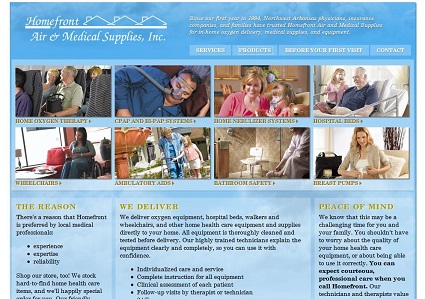Your cart is currently empty!

Product Photos at Your Website
If you sell something tangible, you need to show pictures of your products. Product photos are extremely important for conversion at your website, and they make all the difference for your online image.
The kind of product photos you need will depend on your business, though.
On the right you can see the website we built for Homefront Air and Medical Services, a company that provides home health care products like oxygen, bedpans, and wheelchairs.
Products like these are challenging to photograph. They’re not attractive. Yet people are likely to come to this site for very basic information about unfamiliar items. What the heck is this nebulizer thing their doctor has recommended? How much space needs to be cleared for a hospital bed? Are breast pumps the kind of thing you can tuck in your briefcase? Clear product photos are essential.
It’s also important that a site of this kind, which is likely to be accessed during times of stress in a customer’s life, be reassuring and pleasant. The client asked us to make a point of using images that showed happy, active people using oxygen and wheelchairs.

Where can you get product photos?
The first place to look for product images is the manufacturer of the product. Don’t think that you can grab images from their company website without permission just because you sell the stuff. Fortunately, many companies — including most of the companies Homefront works with — have galleries of images their retailers are allowed to use for marketing.
Call your vendors and ask. Normally you’ll need log in information, and you should give that info to your web pros so they can choose images that fit well with their concept.
In some cases — and Homefront was one of them — the designer can’t just pick the oxygen mask or breast pump that goes best in the design. If there are specific pictures or products that you want to use, you should go ahead and download them yourself and send them to the designer. Even though you know exactly which products are the popular ones, chances are good that your designer will make some wrong guesses if you say, “Just pick any of the popular models.”
Make sure to check the rules for use of the images: must you give credit or provide a link to the manufacturer? Usually this isn’t necessary, and it often isn’t desirable, since it may lead either to customers ordering directly or to an impractical number of special orders. However, if it’s a requirement for you to use the photo, do it. Having permission revoked can mean lots of extra hours searching for replacement images.

For inner pages, you may need more detailed images of the item that show specific features. Again, the manufacturer will be your best source. It is possible to take those pictures yourself, of course, but amateur shots of an object tend to have background problems. A picture of a wheelchair in a normal setting will not show the features of the wheelchair clearly. Getting the object on a clean background is surprisingly difficult; there’s almost always a stray shadow or differences in lighting from one shot to another.
Sometimes clients suggest that we just remove the background with Photoshop, and of course this can be done. With a complex object on a complex background, though, it’s such a time-consuming process that it’s usually cheaper to hire a photographer. As you can see from our photo shoot snapshot below, you can get good professional shots under all kinds of circumstances.

How to use product photos
Once the correct pictures have been found or created, you should choose the ones that work best from the point of view of colors (as Tom did on the homepage, picking images with blue, beige, and pink) and also of line. If the picture you choose will have the object facing out of the screen, you can flip it horizontally, unless there are words on the image. You’ll notice that all the pictures for the Homefront homepage also were sized to the same proportions, and that the proportions fit evenly across the space with even bars of blue between them.
For the inner pages, we didn’t have access to completely uniform images, but they’ve all been sized and aligned uniformly and given matching borders.
Taking the time to fix these things will improve the overall look of your page.
If you are preparing images for Amazon, Woocommerce, or another platform with specific requirements, make sure to be familiar with those requirements before you choose or take your photos.
Once you’ve gotten your photos, make sure to use them all over the place. Duplicating words from one place to another is bad for SEO, but using the same pictures just makes your investment go farther. Use your great product photos in ads, blog posts, slideshows, online directories, email newsletters, and everywhere else you can think of. Just make sure you have permission to use them in the way you’re using them.
by
Tags:

Leave a Reply